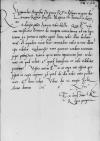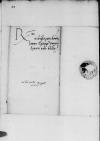Letter #2984
Sigismund II Augustus Jagiellon to Ioannes DANTISCUSVilnius, 1546-07-07
| received Rössel (Reszel), 1546-07-14 Manuscript sources:
| ||||
Text & apparatus & commentary Plain text Text & commentary Text & apparatus
Reverendissimo in Christo Patri, domino
Reverendissime in Christo Pater sincere nobis dilecte.
Quae Paternitas Vestra cum consiliariis Prutenis de tempore mittendorum ad nos legatorum ex sententia nostra egerit, litterae nobis illius declararunt et equidem ratio haec commodior nobis in rem illorum esse videtur. Gedanenses vero quamvis eandem rationem sequi potuissent, tamen quia morae impatientes sunt, audiemus eos, quid velint, et quod honestum ac utile videbitur, faciemus. Vestra autem Paternitas in eo erga nos officio persistat, ut coepit, cupimus. Id, quod de illa nobis certo pollicemur.
Et bene valeat.
Ex commissione
serenissimae

